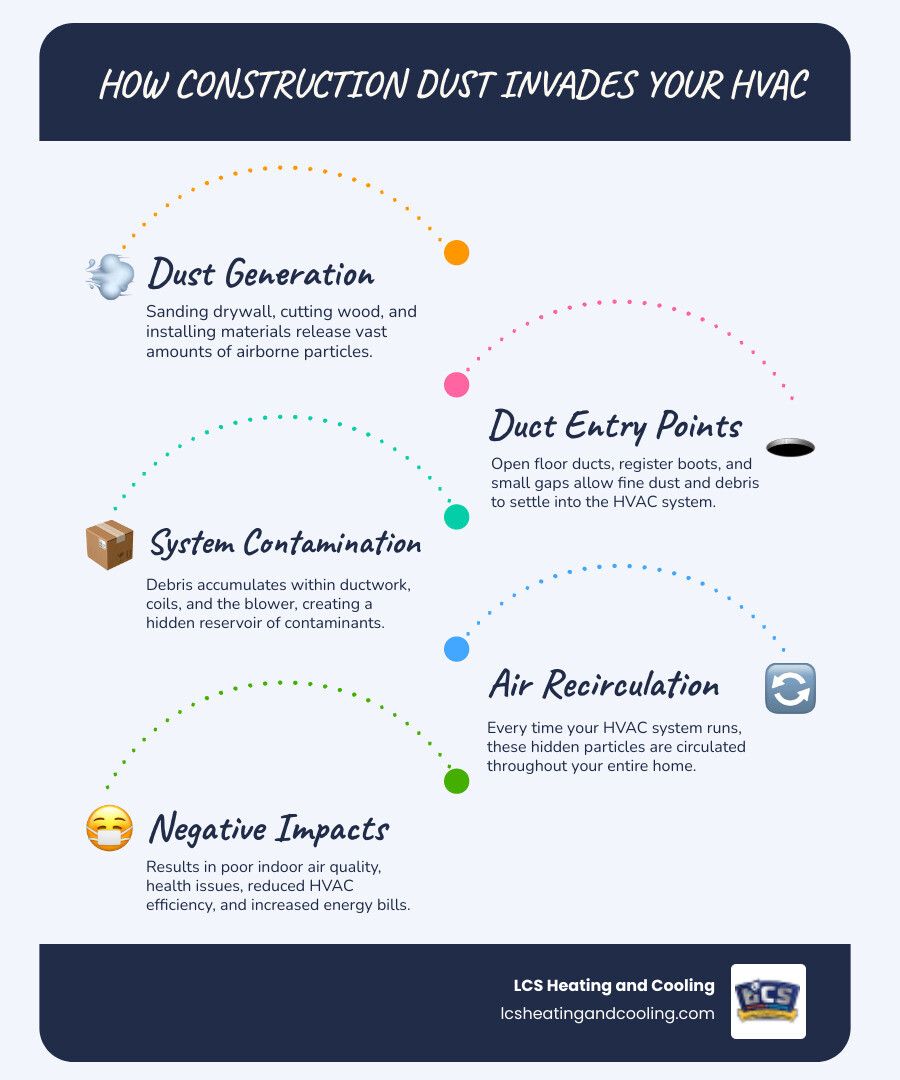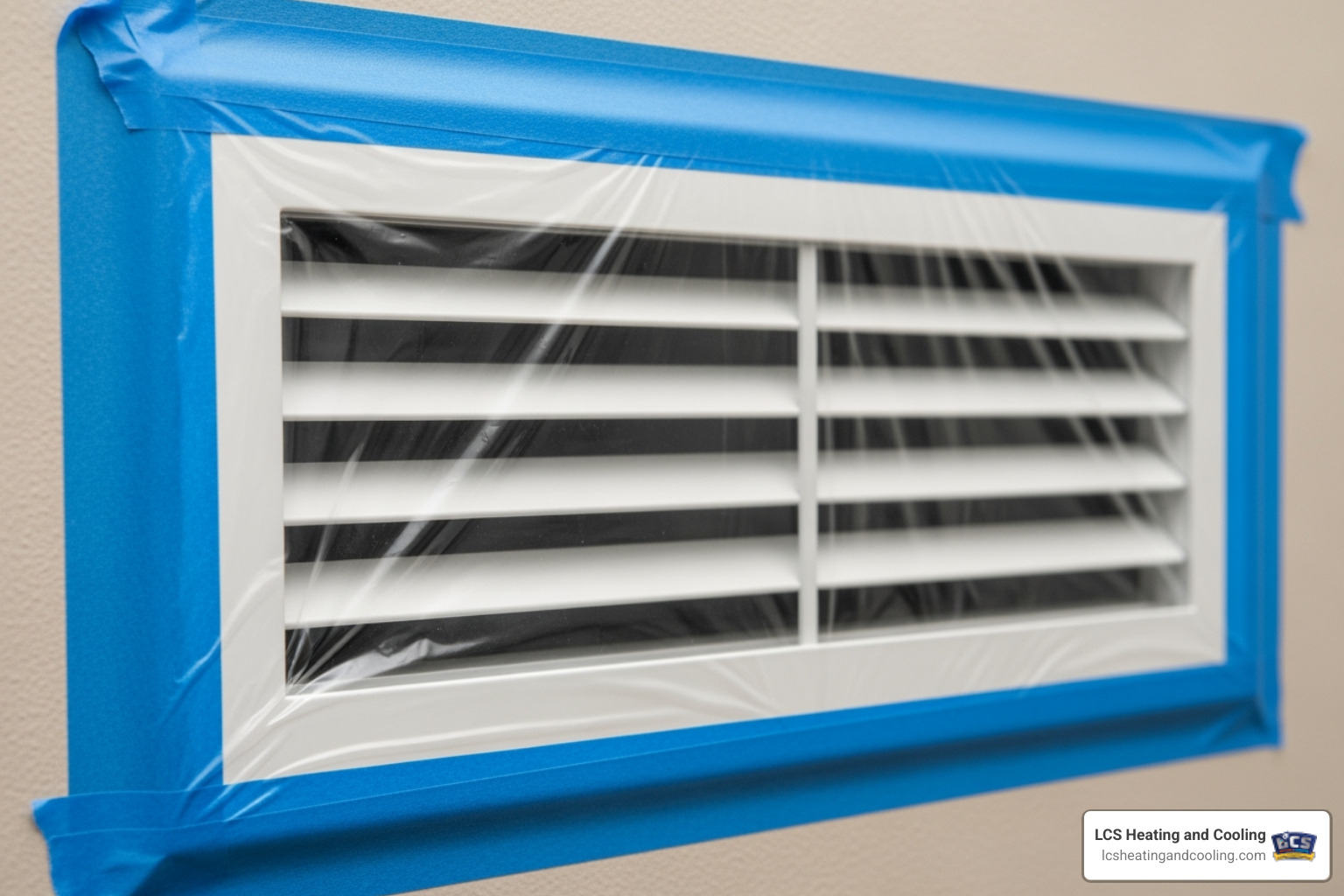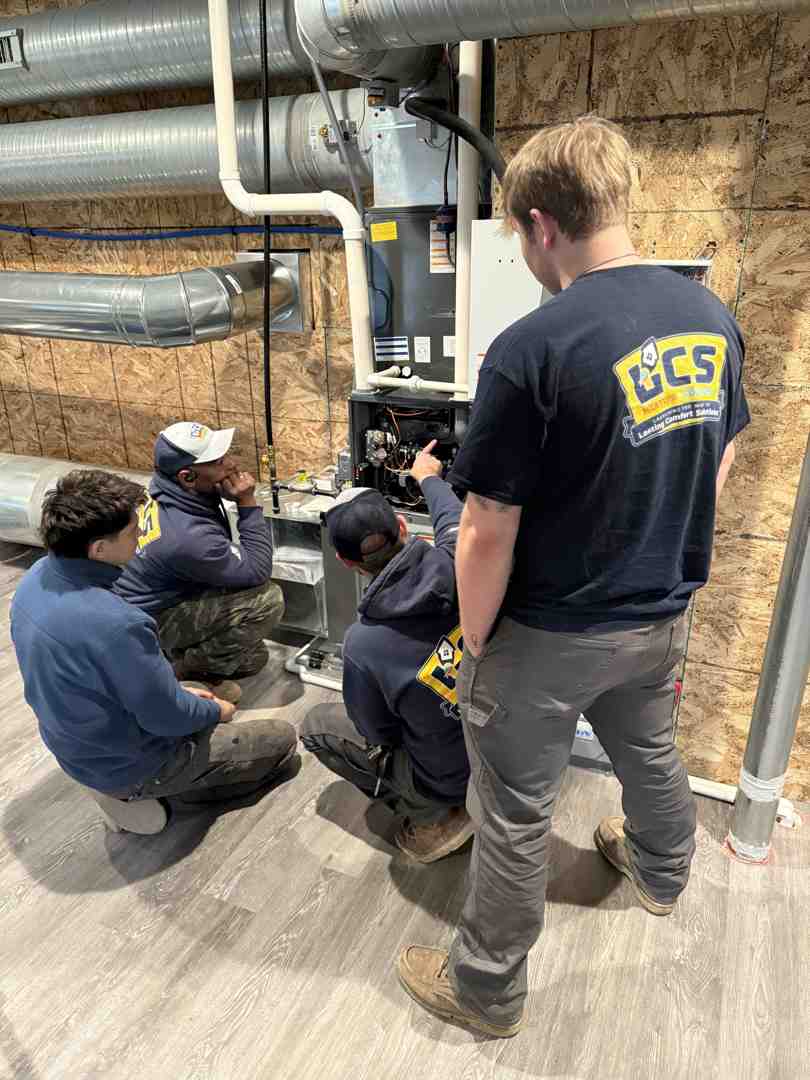Your New Home's First Breath: Why Post-Construction Duct Cleaning Matters
Why Your New Home's Air Starts Behind the Walls
Post construction duct cleaning is a critical step many new homeowners overlook. While your new home looks pristine, construction leaves a hidden mess in your HVAC ductwork. Drywall dust, sawdust, and other debris settle in your air ducts, recirculating every time your system runs. Before you move in, cleaning your ducts can protect your family's health and your HVAC investment.
Do You Need Post-Construction Duct Cleaning?
You should strongly consider it if:
- Your HVAC system ran during construction – Even with filters, fine dust enters the system
- Visible dust blows from vents – A clear sign of contaminated ductwork
- You notice construction odors – Paint fumes, adhesives, and VOCs trapped in ducts
- Drywall was sanded or wood was cut – Activities that generate massive amounts of airborne particles
- You're moving into a newly built home – Builders rarely clean ducts before handover
For comprehensive HVAC maintenance in your new home, explore our Indianapolis HVAC services, or schedule a duct inspection today.
Construction dust isn't just unsightly—it contains fine particles like silica and volatile organic compounds that can aggravate allergies, trigger asthma, and force your HVAC system to work harder. A new home can accumulate pounds of debris in ductwork left open during construction. Even if vents were covered, fine particles still get in.
The longer this debris sits, the more it circulates, coating surfaces, clogging filters, and restricting airflow. Post construction duct cleaning removes this contamination before it becomes a long-term problem, ensuring your new home's first breath is truly clean.

The Unseen Mess: Why Construction Leaves Your Ducts Dirty
During construction, activities like sawing, sanding, and painting send particles into the air. Unfortunately, your HVAC ductwork becomes an unintended collector for this debris.
Open floor registers act like funnels for drywall dust and sawdust. Even when vents are sealed, fine particles find their way through gaps. It's nearly impossible to keep dust out completely when the system is installed before the messiest work begins.
If the HVAC system runs during construction, it pulls paint fumes, adhesive vapors, and other volatile organic compounds (VOCs) into the ductwork, where they can linger for months. Airborne particles from ongoing work settle throughout the system, leaving pounds of contamination behind.
What Contaminants Are Hiding in Your New Ductwork?
The debris in post-construction ductwork goes beyond regular household dust. Fine particulates are the biggest concern—these microscopic particles bypass standard HVAC filters and are easily inhaled.
Silica dust from cutting concrete or brick poses serious respiratory risks. Wood dust can irritate lungs and trigger allergies. Plaster and drywall dust easily clogs filters and coats the inside of ducts.
Insulation fibers can enter the airstream, and carpet fibers get pulled into return vents. Sometimes, actual construction trash like food wrappers falls into open ducts.
Then there are the chemicals. VOCs from paint, varnishes, and adhesives can absorb into dust particles, creating lingering odors. Organizations like SMACNA recognize these risks in their Duct Cleanliness for New Construction Guidelines, emphasizing that when prevention fails, cleaning is essential.
How Debris Impacts Your Home's Air Quality
This debris doesn't just sit in your ducts. When you turn on your HVAC system, it becomes airborne again, changing the system into a distribution network for contaminants.
Poor indoor air quality is an unwelcome result. The air can feel dusty, and a fine layer of grit may settle on surfaces soon after cleaning. These are health concerns, especially for children, the elderly, or anyone with asthma or allergies.
Lingering odors are another sign. Paint and adhesive fumes trapped in ductwork can circulate for months. We've worked with homeowners who couldn't figure out why their brand-new home still smelled like a construction site—until we cleaned their ducts.
Perhaps most troubling is the potential for microbial growth. Debris and moisture create an ideal environment for mold and bacteria, which significantly worsens air quality.
The EPA's guidance in Should You Have the Air Ducts in Your Home Cleaned? is clear: cleaning is warranted when ducts contain excessive debris or when particles are being released into your home. Post-construction scenarios fit this description, making post construction duct cleaning necessary for clean air.
The Risks of Dirty Ducts: Health Hazards and HVAC Strain
Without proper post construction duct cleaning, new homeowners often breathe in construction leftovers. This hidden mess creates real consequences for your family's health and your HVAC system.

Many new homeowners face persistent coughing, high energy bills, or early HVAC repairs—predictable results of contaminated ductwork.
Health Risks from Inhaling Construction Dust
Breathing construction debris daily can cause respiratory irritation, like a nagging cough, frequent sneezing, or a scratchy throat. You're not sick; you're inhaling drywall dust and silica particles.
For those with allergy symptoms, construction dust is a relentless trigger, causing runny noses, itchy eyes, and congestion that makes your new home feel less like a sanctuary.
If a family member has asthma, dust laden with silica and VOCs can trigger asthma attacks, making it difficult to breathe comfortably.
Then there's VOC exposure. These compounds from paints and adhesives release gases, causing headaches, nausea, dizziness, and irritation of your eyes, nose, and throat.
It's worth noting that while some companies might suggest applying antimicrobial treatments or sealants—as discussed in resources like Regulating Antimicrobial Pesticides—the EPA and industry experts generally don't recommend their routine use. The long-term health effects aren't fully understood, and these treatments don't address the root problem. Physical removal of debris through proper post construction duct cleaning is the safest, most effective solution.
How Construction Debris Damages Your HVAC System
Your health isn't the only thing at risk. Your brand-new HVAC system takes a beating when forced to operate with contaminated ductwork.
Construction dust coats every internal surface of your HVAC system, causing restricted airflow. Fine particles on filters, blowers, and coils force your system to work harder to push air through.
This struggle leads directly to reduced energy efficiency. Your HVAC runs longer and consumes more power, increasing utility bills while providing less effective heating and cooling. The EPA's Energy Star website emphasizes that clean airflow is crucial for efficiency.
The blower motor strain is particularly concerning. Pushing air against dust-clogged pathways overworks the motor, leading to burnout.
Your evaporator and condenser coils also get clogged with fine particles. When coated in dust, they can't transfer heat effectively and can even freeze up in cooling mode.
All these issues lead to premature system failure. An HVAC system designed to last 15 years might fail much sooner when battling construction contamination. The repairs and replacement will cost far more than preventive post construction duct cleaning.
Increased utility bills are another consequence. An inefficient system leads to higher energy consumption and longer run times, which add up on your monthly statement.
At LCS Heating and Cooling, we protect your family's health and your investment. Our 7-Star Concierge Service ensures you understand how proper cleaning protects your home's air quality and HVAC longevity.
Your Role: Prevention, Signs, and Scheduling
While professional post construction duct cleaning is often the final solution, proactive steps can dramatically reduce contamination during the building process. Protecting your ducts during construction means they'll be cleaner when you're ready to move in.

Being aware of what can go wrong—and knowing the signs that your ducts need attention—puts you in control of your new home's air quality.
Can You Prevent Duct Contamination During Construction?
Prevention is worth its weight in gold when it comes to keeping your ductwork clean. The most important step? Sealing registers and covering vents with plastic sheeting and tape before any major work begins. This simple barrier prevents sawdust and drywall particles from falling directly into your system.
Crucially, avoid using the HVAC during construction. Running the system during dusty activities pulls fine particles directly into the ductwork, bypassing standard filters. As the EPA's Indoor airPLUS Technical Bulletin Duct Protection During Construction confirms, you should not run your HVAC during these phases.
Regular job site vacuuming with HEPA-filtered vacuums also helps by reducing the amount of airborne dust.
Finally, communicating with your contractors about duct protection sets clear expectations from the start. A quality builder will have procedures in place, but it never hurts to ask about their plan.
Signs You Need Post-Construction Duct Cleaning
Even with preventative measures, some contamination is likely. Here's how to know if your ducts need cleaning:
- Visible dust blowing from vents is the most obvious red flag. If you see puffs of white dust shooting out of your registers, your ductwork needs help.
- Gritty dust settling on surfaces that reappears within a day or two of cleaning is a sign it's being recirculated from contaminated ductwork.
- Persistent construction smells like paint or adhesives indicate that odors are trapped in your ducts.
- Uneven airflow to certain rooms can indicate blockages from debris.
- New or worsened allergy symptoms after moving in, such as unexplained coughing or sneezing, could point to contaminated ducts.
The Ideal Time to Schedule Service
Timing is critical for post construction duct cleaning. Schedule it too early, and you'll need it again; too late, and you've already been breathing contaminated air.
The sweet spot is after all construction is completely finished, with no more dust-generating activities.
Ideally, schedule cleaning before moving in furniture. An empty home allows for more thorough and efficient work.
Pro tip: have ducts cleaned before the final cleaning crew arrives. Duct cleaning can dislodge dust, so it's best to do it before the final surface cleaning.
Most importantly, avoid running your HVAC system for extended periods before the ducts are professionally cleaned. Running the system just spreads debris throughout your home and into the system's components.
The Professional Solution for Post Construction Duct Cleaning
Post construction duct cleaning requires professional expertise and equipment that a DIY approach can't match. The fine particulates, VOCs, and other debris in your ductwork demand specialized tools for safe and complete removal.
A professional service ensures debris is removed without damaging your HVAC system or spreading contaminants. At LCS Heating and Cooling, our 7-Star Concierge Service means we're not just cleaning your ducts—we're protecting your investment and your family's health with thoroughness and care.

The Professional Duct Cleaning Process Explained
A thorough cleaning follows the rigorous standards set by the National Air Duct Cleaners Association (NADCA), outlined in The NADCA Standard for Assessment, Cleaning & Restoration of HVAC Systems. Here's what that looks like.
We start with a comprehensive system inspection to understand the extent of contamination and identify your ductwork type. This guides our cleaning strategy.
Next is negative air pressure containment. We connect powerful, HEPA-filtered vacuums to your ductwork. This creates a contained system where dust is pulled out and trapped, not blown back into your home.
While under negative pressure, we use mechanical agitation tools like rotary brushes and air whips to dislodge stubborn debris from duct surfaces. We select tools based on your ductwork material to prevent damage.
The cleaning extends to your coils and blowers. Your evaporator coils, fan housing, and blower motor all collect dust that reduces efficiency. Cleaning these components restores your system's performance.
We also remove, wash, and sanitize every register and grille.
Finally, we conduct a final inspection and sealing. We visually verify the ducts are clean, seal any access points, and test your system's operation.
What to Look for in a Reputable Duct Cleaning Company
Choosing the right duct cleaning company is crucial. A poor choice can lead to damaged ducts or spread contaminants. Here's what to look for in a professional service.
NADCA certification should be at the top of your checklist. The National Air Duct Cleaners Association sets the gold standard for HVAC system cleaning. You can verify certification and find a NADCA professional duct cleaner near you through their website. This certification represents a commitment to doing the job right.
Look for companies that also follow Air Conditioning Contractors of America (ACCA) standards. These guidelines ensure a comprehensive approach to HVAC system quality.
Proof of insurance is non-negotiable to protect your property.
A professional company should provide visual inspection evidence of their work, showing you before-and-after results.
They should be transparent about their process, equipment, and any limitations, such as how they handle fiberglass duct board.
Be cautious of suspiciously low prices or bold health claims. Quality post construction duct cleaning requires time, expertise, and professional equipment at a fair price.
At LCS Heating and Cooling, we bring these qualifications to every job, plus our 7-Star Concierge Service commitment. We keep you informed, respect your home, and ensure you're satisfied with the results.
Conclusion: Ensure Your New Home Breathes Clean from Day One
Your new home is a fresh start and a sanctuary. Don't let hidden construction debris undermine your comfort and health from day one.
As we've covered, construction leaves behind contaminants like fine particulates, silica dust, and VOCs in your ductwork. These pose real risks, including poor indoor air quality, respiratory issues, and HVAC strain leading to higher energy bills and premature system failure.
The good news is that you can prevent these problems. Post construction duct cleaning is an investment in your family's health and your HVAC system's longevity. By choosing professional cleaning before you move in, you ensure clean air, peak HVAC efficiency, and no lingering construction smells.
At LCS Heating and Cooling, we understand moving is overwhelming. That's why our 7-Star Concierge Service is built to make your life easier. We show up on time, communicate clearly, and streamline the process with the respect you deserve. We're not just cleaning ducts—we're helping you create a healthy foundation for the years ahead.
Serving Indianapolis, Carmel, Fishers, Lawrence, Noblesville, and Zionsville, we've helped countless families breathe easier in their new homes. We've seen the difference that proper post construction duct cleaning makes, from eliminating coughs to improving HVAC efficiency.
Don't let construction debris be your new home's unwelcome housewarming gift. For more information about our comprehensive duct cleaning services in Indianapolis, or to schedule your post-construction cleaning, contact us today. Let's make sure your new home breathes clean from the very first day—because you and your family deserve nothing less.


